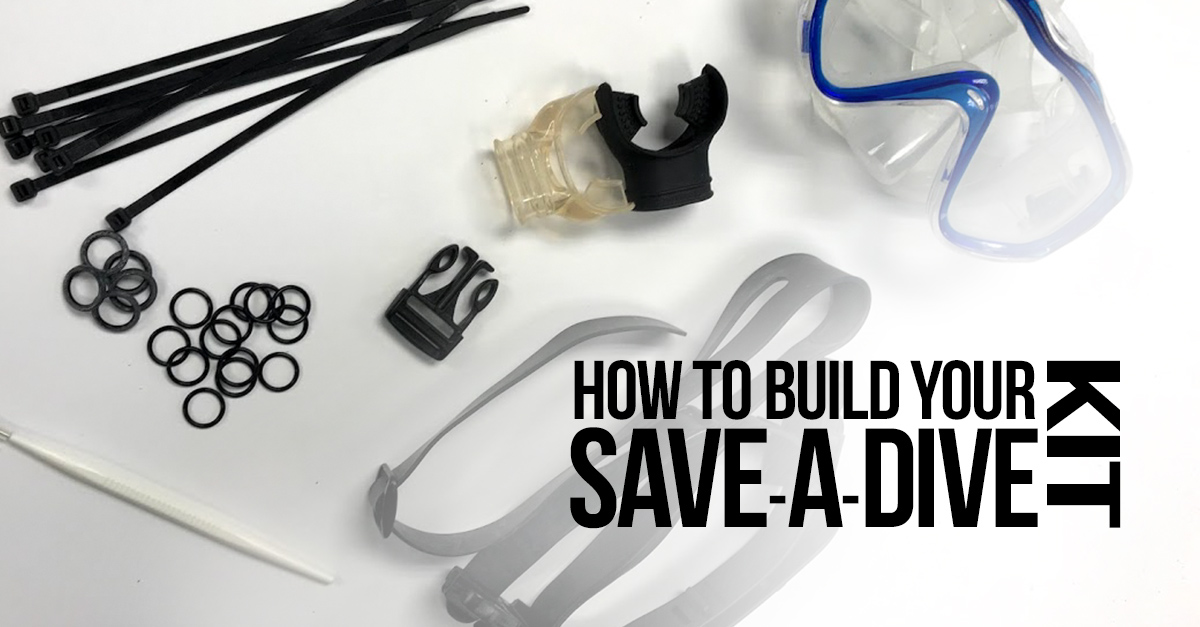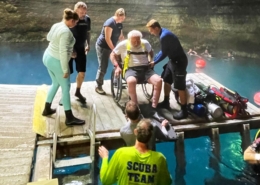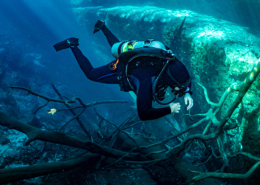How to Build Your Save A Dive Kit
By Kate Heller
“My fin strap broke.” “My tank o-ring is missing.” “My student’s BCD isn’t holding air.” Whether you’re a new, experienced, or professional diver, at one point or another you’ll encounter a reason to need a save-a-dive kit. It can seem difficult and overwhelming at first to decide what to add to your save-a-dive kit at any level, but it is actually fairly simple. You’ll want to consider a few things. First, think about Murphy’s Law, “What can go wrong will go wrong.” Second, analyze every aspect of the dives you’ve done thus far in your career. Third, think about the gear you have and what part(s) of it you might need to save during a day of diving. Keeping those in mind, we’ll look at a save-a-dive kit from the beginning diver’s kit to that of the instructor.
As a new open water diver who’s eager to continue their SDI diving career, you start to add to your personal gear. To start your own save-a-dive kit, you’ll want to look into getting a small dry box to fit everything you might need for your basic equipment. This would include your own mask, boots, fins, snorkel, etc. Aside from gear, also think about yourself as a diver. Keeping the 3 aspects to consider from above in mind, let’s look at each piece of gear.
Mask, Boots, Snorkel, Fins
- What can go wrong?
- Mask strap breaks
- Mask keeps fogging up
- Zipper on the boots breaks
- Snorkel keeper breaks
- Fin strap breaks
- Fin buckle breaks
- Hair tie breaks
- Analyze the dives you’ve done
- What’s been suggested to compensate for the mask problems?
- Could the boots be too tight so the zipper is distressed?
- Has the snorkel keeper come off during a dive already?
- Have you had to adjust the strap during your dive?
- Has the buckle come loose or unbuckled itself during a dive?
- Have you lost or broken a hair tie?
- The parts you might need
- Spare mask strap
- Defog
- Tape to hold the boot in place for the time being until you can acquire a new set
- Zip-tie to replace the broken zipper
- Spare snorkel keeper either plastic, silicone, or neoprene
- Extra fin straps
- Extra fin buckles
- A pack of hair ties
- Miscellaneous items to consider
- C-cards
- Extra snorkel/regulator mouthpiece
Even though your instructor, a boat crew member, or someone on site might have a back up of any of the aforementioned parts, it is best to build your own save-a-dive kit. It will help you as a newer diver to be prepared for the unexpected as well as help you to understand how to fix some of your own gear issues and become more independent as a diver.
Once you continue in your diving career and gain more experience, you’ll witness problems that other divers have had. You’ll see or talk about what they did to compensate for their issues and from that knowledge, be able to add to your save-a-dive kit. Whether you add a BC, regulator, computer, or wetsuit to your gear collection or expand on where you dive, you’ll have more to consider come building your kit.
BC, Wetsuit, Computer, Regulator
- What can go wrong?
- Dump valve gets cracked
- String to the dump valve breaks
- Inflator button sticks
- Wetsuit zipper breaks
- Wetsuit zipper leash breaks
- Wetsuit rips or tears
- Tank that was rented is missing or blew an o-ring
- Computer is dead
- A hose leaks
- Analyze the dives you’ve done and will do
- Is this leak one that can be fixed on site?
- Can the zipper be fixed or have a temporary rig set up?
- How many dives until the rip or tear gets worse?
- Is the wetsuit difficult to zip up?
- What does the boat crew do if an o-ring blows?
- Have you been taught to change a battery?
- The parts you might need
- Spare dump valve
- Paracord or braided nylon line
- Wetsuit cement or patch
- Zipper wax/lube
- O-ring pick
- Tank size o-rings
- Computer batteries
- Extra regulator hose
- Miscellaneous items to consider
- Extra pressure gauge
- Extra bolt snaps and clips
If recreational diving is as far as you wish to go and you want to explore more areas of recreational diving such as wreck, deep, sidemount, etc. you’ll want to continue referring back to the 3 aspects of diving to consider. From there, you’ll be able to build even further on your kit. You’ll also be a source of knowledge for the new divers that you meet and connect with.
If diving has become a passion that you want to share and educate others about on a professional level, there are other aspects of a save-a-dive kit as well as training to consider on top of your already assembled personal Kit.
Students’ Gear (Personal and Rented), Miscellaneous Gear and Equipment
- What can go wrong?
- Student’s regulator is free-flowing
- Student’s ears wont clear
- Hose is leaking bubbles at the 1ststage
- Student forgets computer
- Computer dies
- Analyze the divers you’ve taught as well as past personal dive experience
- What are the common problems you’ve seen while helping with a class?
- What were the quick solutions for those problems?
- What did you need to alleviate the problem?
- The parts and tools you might need
- Allen keys
- Adjustable wrenches
- Needle nose pliers
- Extra LP/HP hoses
- Port plugs
- Variety of sized o-rings
- Scissors
- Dump valves, inflator hose
- Miscellaneous items to consider
- EarShield
- Extra sunscreen
- Motion sickness pills
As an instructor, this save-a-dive Kit will not only be an asset to you but also a learning tool for your students. It will help educate them early about thinking of all the components that need to be considered when diving. It’s great to have everything for them, but creating a diver that can be a self-reliant problem solver without you there is a huge skill advantage.
A save–a-dive kit is such an important tool for all levels of diving. It provides a sense of reassurance knowing that you have the tools to fix what needs to be fixed. As you further your diving career, you’ll want to consistently think about the 3 aspects of that style of diving. What can go wrong, analyze other similar dives that you’ve done, and what tools or gear can you put in your kit to alleviate or prevent those problems from occurring. Though the above lists of items are helpful starting points, there are an infinite number of pieces that a diver, novice or experienced, and an instructor can add to their kits. When creating your save-a-dive kit, cater it to your personal needs and diving environment. Talk to others and observe what they have in their kits to help get a better idea of some additions to yours. Keep in mind that, much like diving, you should not try to solve an issue that you haven’t encountered before or don’t have the training to adequately handle. You’ll always want to take the courses necessary to know how to fix the problem as well as ask for help. What are some of the components in your save-a-dive kit?










Ответить
Хотите присоединиться к обсуждению?Не стесняйтесь вносить свой вклад!